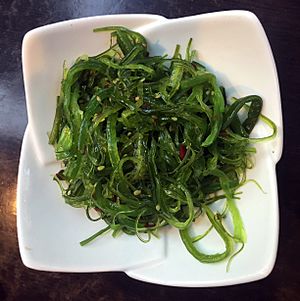Wakame facts for kids
Quick facts for kids Wakame |
|
|---|---|
| Scientific classification | |
| Kingdom: | |
| Division: | |
| Class: | |
| Order: | |
| Family: |
Alariaceae
|
| Genus: |
Undaria
|
| Species: |
U. pinnatifida
|
| Binomial name | |
| Undaria pinnatifida (Harvey) Suringar, 1873
|
|
Wakame (pronounced wah-KAH-may) is a type of kelp, which is a large kind of seaweed. Its scientific name is Undaria pinnatifida. People around the world eat wakame, especially in Asian countries.
Wakame is often sold dried or salted. You might find it in popular dishes like miso soup and salads. In Korea, this seaweed is called miyeok. It's used in salads or as the main ingredient in a special soup called miyeok soup. In China, it's known as qundaicai. A lot of Chinese wakame comes from the area around Dalian.
Contents
Wakame: An Invasive Species
In some parts of the world, wakame has become a serious problem. For example, in New Zealand, Undaria pinnatifida is considered a very harmful weed. It's even listed as one of the 100 worst invasive species globally.
How Wakame Spread to New Zealand
Wakame was first seen in Wellington Harbour, New Zealand, in 1987. Scientists believe it probably arrived by accident in the late 1980s. It likely traveled on ships from Asia, hidden in their ballast water. Ballast water is water that ships take in to help them stay stable.
Where Wakame Comes From and Where It Has Spread
Wakame naturally grows in the cold coastal areas of Japan, Korea, and China. However, it has recently spread to many other countries. These include France, Britain, Spain, Italy, Argentina, and Australia.
How Wakame Spreads in New Zealand
Today, Undaria can be found across much of southeastern New Zealand. It has even reached as far north as Auckland. This seaweed spreads in two main ways:
- Naturally: Each adult plant releases millions of tiny, microscopic spores. These spores can float away and start new plants.
- By human activity: It can also attach itself to the hulls (bottoms) of boats and to equipment used in marine farming. This helps it travel to new places.
Undaria is very good at growing and reproducing. This makes it a highly successful invader that can take over new areas quickly.
Images for kids
-
Undaria pinnatifida growth stages, from sprouts to young adults. These were found in Monterey Harbor, California.
-
Miyeok guk, a Korean soup made with miyeok






